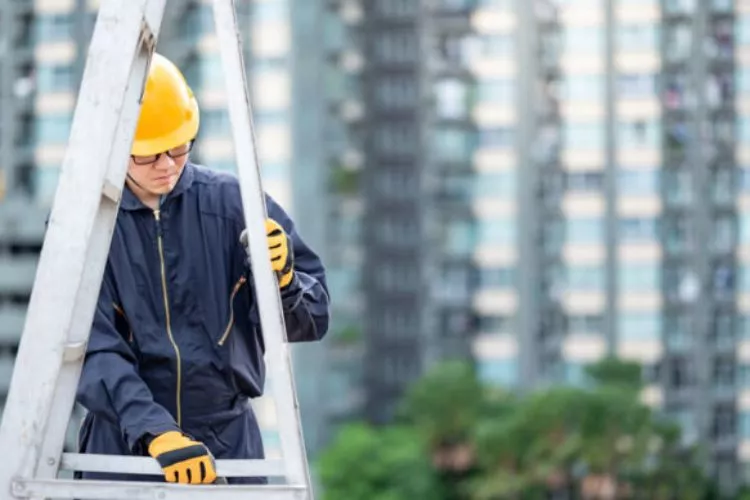When using a ladder, it is important to follow safety rules. In the next sections, you will learn the main reasons ladders fail when overloaded. We will guide you in selecting the right ladder for the job.
You will also gain valuable tips on proper ladder usage. By being aware of what are the risks of overloading a ladder, you can prevent injuries and accidents. Make sure to read through to improve your ladder safety knowledge.

What Are The Risks Of Overloading A Ladder?
Ladders are everyday tools. We use them at work or home. But they can be dangerous. Many accidents happen because of overloading a ladder.
This section will explain the risks of overloading a ladder. We will share information to keep you safe. Keep reading to understand how to use a ladder properly.
Ladder Collapse
One risk of overloading a ladder is collapse. This happens when the ladder’s weight limit is passed. The ladder can then bend or break under the weight.
This causes a sudden fall. People can get hurt or items can get damaged. Always check the weight limit first.
Slip and Fall
Another risk is slipping and falling. If the ladder is overloaded, it becomes unstable. It can wobble or shift position. This can cause the person on the ladder to lose their balance and fall.
Damage to the Ladder
A ladder is made to bear a certain weight. When overloading occurs, the ladder can be under enormous pressure. This pressure can lead to several forms of damage.

Bending Rungs: Rungs are the horizontal parts you step on. They can bend when subjected to too much weight. This bending can make the rungs weak. Over time, the rungs may not be able to hold even normal weight. This could be hazardous when someone later steps on these rungs.
Warping Frame: The frame is the backbone of a ladder. It holds everything together. When a ladder is overloaded, the pressure can cause the frame to warp or distort. This can create a lean or curve in the ladder, undermining its stability.
Cracks and Breaks: Too much weight can also cause cracks or breaks in a ladder. This is usually a problem with wooden ladders but can happen with metal ones too. Tiny cracks might appear first, which might not be visible right away. But with time, these cracks can become bigger, leading to parts of the ladder breaking off.
Loose Bolts and Nuts: An overloaded ladder subjects the nuts and bolts to high stress. They can start to loosen as a result. Loose nuts and bolts can make the ladder unstable and risky to use.
In summary, overloading can cause serious and sometimes unnoticeable damage to a ladder. This is why it’s crucial to stay within the weight limit recommended by the ladder’s manufacturer.
Increase in Accident Risk: Finally, overloading a ladder increases the risk of accidents. The more weight a ladder carries, the more likely it is to fail. And when a ladder fails, the result is usually an accident. Falls from ladders can cause broken bones, head injuries, and other serious harm.
Prevent Overloading Risk: Choose the Right Ladder
It is important to choose the right ladder for the task. Check the ladder’s weight capacity. Also, consider the weight of any tools or materials that may be on the ladder.

A heavy-duty ladder can carry more weight without breaking. But you should still not go over the weight limit.
Follow Safety Rules
Here are some safety rules to follow:
- Only one person should be on the ladder at a time.
- Keep your body centered between the rails.
- Do not lean too far to the side.
- Always have three points of contact with the ladder (two hands and a foot, or two feet and a hand).
Using a ladder may seem simple. But it is crucial to respect the rules. It will help you avoid the risks of overloading a ladder. Being aware and vigilant keeps you safe while using a ladder.
This article has focused on the risks of overloading a ladder. These include ladder collapse, slips and falls, damage to the ladder, and increase in accident risk. The way to avoid these risks is to choose the right ladder and follow safety rules. Safety must always come first when using a ladder.
What is the Biggest Cause of Ladder Accidents?
The biggest cause of ladder accidents is misuse. This can include overloading the ladder, using a ladder with a lower weight capacity than needed, or using the ladder improperly. People often lean too far to one side, causing the ladder to tip over.

Or they stand on the top rungs, which is not safe. They might also set up the ladder on an uneven or slippery surface. These and other such misuses are the leading cause of accidents involving ladders.
What are the OSHA Violations for Ladders?
The Occupational Safety and Health Administration (OSHA) sets rules for ladder use in the U.S. Many people commit OSHA violations without even knowing it. Here are a few examples:
- Incorrect usage of ladders: OSHA requires that the user face the ladder while climbing up or down. You should also use both hands. But people often break these rules. This leads to accidents and OSHA violations.
- Improper ladder setup: OSHA requires that ladders be set up on a firm, level, and stable surface. Using a ladder on a slippery, uneven, or unstable surface is a violation.
- Overreaching: According to OSHA, you should never lean so far to the side that your body goes past the ladder’s side rails. Doing so is not only unsafe but also an OSHA violation.
- Ladder maintenance: OSHA mandates that ladders need to be well maintained. Damaged steps, missing non-slip feet, or loose bolts are safety hazards. Using a poorly maintained ladder is a violation.
- Exceeding load capacity: As we have discussed, overloading a ladder can lead to accidents. It is also an OSHA violation.
- Improper use of top steps: OSHA rules state that the top step or top cap of a stepladder should not be used as a step. Doing so is both dangerous and a violation.
If found violating these or other rules, businesses can be fined. Always review OSHA’s ladder safety rules before using a ladder. This helps in preventing both accidents and violations.
You may also find these guides useful to be aware of ladder safety: Are Telescopic Ladders Safe? | Can Lightning Strike An Aluminum Ladder?
Conclusion:
Using a ladder safely is vital to prevent accidents and injuries. The risks of overloading a ladder include collapse, slips and falls, damage to the ladder, and an increase in accident risk.
To avoid these hazards, always check the ladder’s weight capacity, choose the right ladder for the job, and adhere to proper safety rules.
By understanding and respecting the risks associated with overloading a ladder, you can ensure a safe experience for yourself and those around you.


